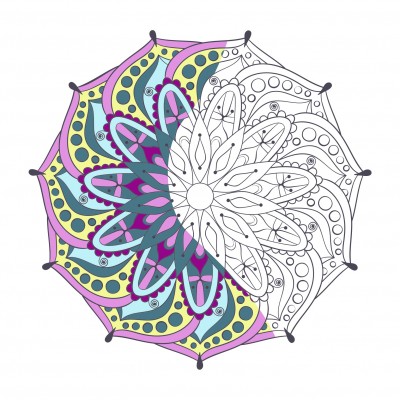
Adult coloring books can help with relaxation – or pave the way to avoidance of the real problem. What should you be aware of about the benefits and potential pitfalls of this beautiful, soothing outlet?
Back in 2008, when I was having a health issue that was going to require surgery, I was grateful to have accumulated a number of ways to decrease the understandable stress in my body as well as my mind. I put to good use the benefits of various relaxation techniques, breathing exercises, guided imagery, and more. The surgery went very well – the surgeon even commented afterwards about how readily my body had responded to his spoken request during surgery to bring my blood pressure down.
During my recovery, my young son was needing something to help him through the stress of mom’s temporary inability to play with him, pick him up, and so on, and he and I came up with the idea of coloring together.
I searched online and found some coloring books and pencils we could both enjoy; he’d watched raptly when we saw some Tibetan Buddhist monks creating a sand mandala, so I bought a couple of mandala coloring books. We both really liked the way we could be side by side, coloring and sharing pencils, and we also both responded well to the relaxed state we got into while “working” on coloring in the designs.
I added the coloring books to the list of resources for my patients, and over the years since then, I’ve enjoyed hearing about their positive experiences with them. (If I do suggest them to patients, I recommend abstract designs. It’s generally easier to relax, engage your less analytical mind, and be less self-critical when you aren’t coloring in something that is “supposed” to look a certain way, like a house or realistic flowers. Also, by engaging the senses more fully,the tactile element of real paper and pencils seems to be more helpful than some of the coloring apps that have sprung up.)
As you’re probably already aware, adult coloring books are now all the rage, topping best-seller lists and finding their way into many people’s lives, for the better.
Now for the significant “however”: Just as with any method of relaxation or distraction or even meditation, there’s the “shadow” side — the chance it will be used as a way to avoid dealing with other issues or one’s difficulties.
So even as a fan of coloring as a tool, I was actually glad to read a recent online article titled, “America’s obsession with adult coloring is a cry for help.”
In a very short time, coloring has proven surprisingly addictive for America’s stressed, anxious, and overworked. Therapeutic without being therapy, meditative without being meditation, creative without being creation, artsy without being art, the supposedly soothing activity has also become a big business—in 2015 alone, US sales of coloring books shot up from 1 to 12 million units.
One of my favorite mindfulness teachers, Jack Kornfield (who is also a psychologist) wrote an important article many years ago about how even mindfulness and spiritual practice can be misused as a way “to hide and avoid problematic parts of [our]selves.”
[T]he sitting practice itself, with its emphasis on concentration and detachment, often provide[s] a way to hide, a way to actually separate the mind from difficult areas of heart and body.Meditation and spiritual practice can easily be used to suppress and avoid feeling or to escape from difficult areas of our lives. Our sorrows are hard to touch. Many people resist the personal and psychological roots of their suffering; there is so much pain in truly experiencing our bodies, our personal histories, our limitations…..
This doesn’t mean getting caught in our personal histories, as many people fear, but learning how to address them so that we can actually free ourselves from the big and painful ‘blocks’ of our past. Such healing work is often best done in a therapeutic relationship with another person.
(Excerpted from Kornfield, J. (1989) Even the Best Meditators Have Old Wounds to Heal, Yoga Journal, 88: 46)
There are so many ways we can help ourselves, and soothe ourselves. They’re vitally important, and incredibly useful tools, but like any self-help tool, they’re best used with an awareness of their limitations, and as a way to build and create more within ourselves, not simply tune out and get in the way of our growth, of becoming our fullest selves. Because the point of living, after all, isn’t just to survive, but to thrive.

